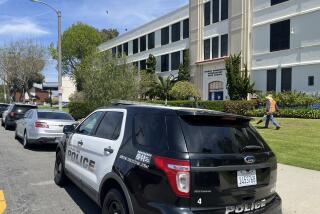Assaults Taint Palos Verdes Schools Known for Safety : Education: Drugs and violence within the district have resulted in the expulsions of a record 11 students this year.
The story of two Palos Verdes Peninsula High School students and a bag of marijuana shows how a quiet school in a district known for safety and scholarship has had to cope with increasing violence this year.
The two friends hatch a plan to sell the pot and split the profits, recalls Bill Howard, a school district administrator who oversees expulsions. But one boy swaps the marijuana for oregano and leaves his would-be business partner with nothing but a bag of cheap spice. To extract revenge, the partner recruits a few students to beat the trickster with a baseball bat. The attack on a campus playing field leaves him with a concussion.
Because of this and other assaults, school officials say, the Palos Verdes Peninsula Unified School District has expelled a record 11 students this year.
Nine of the 11 students attended Peninsula High, which has 2,800 students. Of those nine expulsions, six were for assault, two for possessing or selling marijuana and one for both possessing a knife and assault.
Two expulsions involved students from Miraleste Intermediate School, who attempted to sell marijuana but were caught by school administrators who had been tipped off.
Each of the previous two years, the district expelled only one high school student for selling or possessing drugs, according to school officials.
“We had a dramatic increase in a short period of time,” said school board President Barry J. Hildebrand.
Supt. Ann Chlebicki said the school board, alarmed at the growing number of expulsions, has asked her to search for a program that will teach students how to solve their problems peacefully.
Chlebicki said she hopes to have the program in place by fall.
Officials and PTA leaders were unable to pinpoint the reason for the recent rash of expulsions in the school district, long regarded as a haven of safety and scholarship.
“I have no idea whether it was a full moon or the weather changed,” Hildebrand said.
Howard said that none of the incidents involved guns, and that the baseball-bat beating was the most serious. Three students connected with the attack were expelled, along with the student who was beaten, because he attempted to sell marijuana.
Chlebicki added that none of the assaults involved attacks on faculty members and that the other expulsions did not result from any one event.
The number of assaults at other school districts comparable to Palos Verdes in size and academic achievement appears to be lower.
The Las Virgenes Unified School District, located in the San Fernando Valley, has expelled seven students this year. Three expulsions involved assault. Last school year, the district expelled three students; the year before, two.
The Santa Monica-Malibu Unified School District has expelled 13 students this year. Only one expulsion--of a middle-school student--was for assault. Figures for the previous two years were unavailable.
In Palos Verdes, some blame the media for showing people using violence to solve problems.
“With the baseball strike, at least the media showed the two sides sitting down at a table and discussing things,” Chlebicki said. “But students don’t see that when they go to the movies.”
Michael W. Caston, the former Palos Verdes superintendent, said that one or two students were allowed under his watch to leave the district rather than be expelled. If students voluntarily leave a school district, they avoid the mark of an expulsion on their school records, which can make admission to other schools difficult.
Caston, now superintendent of the Santa Barbara Unified School District, said he could not address the current conditions in Palos Verdes.
But he noted, “All school districts are experiencing more expulsions than they did in the past.”
The reasons he cited include new laws, closer scrutiny of school districts, and a zero-tolerance attitude toward violence and weapons on campus.
But Chlebicki, who took over as superintendent this school year, said the expulsions are not the result of a get-tough policy. She said the expulsions were often mandated by school policy, and in other cases, the district had to use its ultimate weapon because the violence committed by students was so extreme.
County sheriff’s deputies patrol the school and surrounding area, and school board Trustee Joan Davidson said she is alarmed at the number of incidents involving students that they have responded to. But the number of incidents is not unusually high, Lt. Cathy Taylor said.
According to the sheriff’s substation in Lomita, deputies have responded to three incidents involving students at or near the campus since January. In one incident, an 18- to 24-year-old man allegedly beat up a student while she was off campus just after lunchtime.
The girl, who was kicked and punched, suffered a broken nose and concussion. Deputies are still searching for the suspect.
Despite the recent string of events, Hildebrand noted that 10 of the 11 expulsions resulted from incidents that occurred during the fall semester and that the expulsions may have deterred other wrongdoers.
“We didn’t get as many kids who were getting out-of-bounds,” Hildebrand said of the spring semester. But he added, “I don’t know if last fall was an anomaly.”
More to Read
Sign up for Essential California
The most important California stories and recommendations in your inbox every morning.
You may occasionally receive promotional content from the Los Angeles Times.










